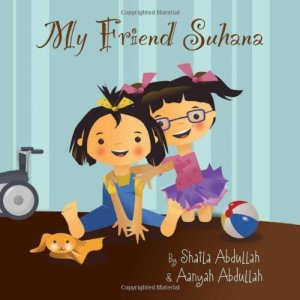 .
.
My Friend Suhana
by Aanyah Abdullah & Shaila Abdullah
Loving Healing Press 1/1/2014
978-1-61599-211-9
Age 6 to 8 30 pages
.
“A simple tale of love and friendship to warm your heart. This is the tale of a little girl who forms a close bond with a child with cerebral palsy. The girl finds that through her art, she can reach her special friend Suhana.”
Opening
“My friend Suhana is like no other girl I know.”
The Story
Suhana has Cerebral Palsy or CP for short. She is a quiet girl who moves little and depends upon others for all her needs. Despite all her limitations, Suhana can communicate. It takes someone special to understand all of Suhana and her needs. The narrator, an unnamed little girl, is trying to be that someone special for Suhana. The young girl, a budding artist, tries to use her art with Suhana. She uses different colors to symbolize Suhana’s various moods. Red equates being upset, blue is calm and pink is love. The young girl rocks Suhana in her arms and shows her the pictures she draws. Both girls are seven-years-old, which is not lost on the young girl.
Review
My Friend Suhana is a sweet homage to a young girl with cerebral palsy from a young girl who tries to be her friend. As narrator, the young girl tells us about Suhana and their relationship. The young narrator displays a great deal of empathy for Suhana, a girl her own age. Suhana’s mother tries to help the young girl understand her daughter. The young narrator volunteers with Suhana each week–
“But for one hour each week I get a chance to rock her in my arms and imagine that she is my special friend!”
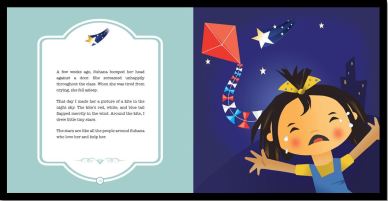
What the young girl fails to realize is that she needs not imagine. Suhana is her special friend and she is Suhana’s special friend. Volunteering at the special needs class, the young narrator begins to understand Suhana through her own art, probably more than Suhana understands what the young artist is trying to say. The young volunteer does not say if she has helped Suhana make her own art, but that would be a great step to take.
As a story, My Friend Suhana falls quite short. The protagonist is the young narrator, telling her own story, but there is no antagonist, unless you consider CP. A teacher tells the narrator that her art can help ease anxiety in others, so the girl starts giving her art to her friends. What changes does this make? Do these kids find relief and does this help the protagonist grow? The narrator is seven-years-old, as was the author when she co-authored this book. She relates her experiences well, but for what reason. What is the story? Where is the conflict that will change her? Who is the protagonist?
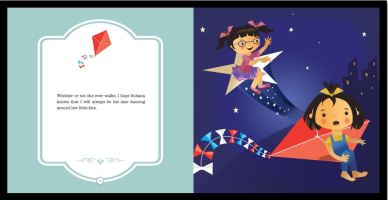
Rather than go into craft, conflicts, and all that stuff the young writer may not grasp, but a story needs, I would rather say this is a fine attempt for a first book. Putting oneself out there with kids who are so extremely different from yourself is difficult. Then telling the world about it, trying to relate what a great kid Suhana is, turns a hill into a mountain and this young author climbs that mountain gracefully and with much empathy. Aanyah is a great kid.
She realistically explains Suhana’s reactions to things she does not like, “she clenches her fists,” and when happy, “she waves her legs and arms wildly.” When Suhana bumps her head she, “screams unhappily . . . tired from crying, she fell asleep.” For seven years of age, this young girl is extremely observant and insightful. Everything the young narrator mentions about Suhana, I have seen repeated many times by kids with CP I have worked with. It takes a special individual with great empathy and patience to help these kids, even more to be a friend. Which is why I would rather exult the young author’s ability to work with others, her empathy, her patience, and her art, which she uses to help others.
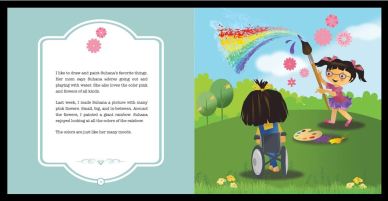
My Friend Suhana is not a story. It is a loving tribute to a special friend and as such can be very helpful for other kids to read. Mainstreamed schools are a great place for this work to be available. Volunteer centers that allow kids to help, is another. Obviously, places with cerebral palsy patients are great places for this work, but any place with young children as clients that allows children to volunteer can benefit from having the volunteers read this young writer’s first work. My Friend Suhana may not be a “story,” but it has a lot of heart.
MY FRIEND SUHANA. Text copyright © 2014 by Aanyah & Shaia Abdullah. Illustrations copyright © 2014 by Shaila Abdullah. Reproduced by permission of the publisher, Loving Healing Press, Ann Arbor, MI.
.
Learn more about My Friend Suhana HERE.
Buy My Friend Suhana at Amazon—B&N—Loving Healing Press—your local bookstore.
.
Meet the author, Aanyah Abdullah at her website: http://myfriendsuhana.com/
Meet author, Shaila Abdullah at their website: http://www.shailaabdullah.com/
Find other interesting books at the Loving Healing Press website: http://www.lovinghealing.com/
.
.
Filed under:
3stars,
Children's Books,
Library Donated Books,
Picture Book Tagged:
Aanyah Abdullah & Shaila Abdullah,
art,
cerebral palsy,
children's book reviews,
CP,
friendship,
hardships,
Loving Healing Press,
relationaships,
volunteerism 







Reviewed by Suzanne Lieurance
Author Jewel Kats takes the sensitive subject of child sexual abuse and turns it into a captivating, yet gentle cautionary tale from Loving Healing Press called Reena’s Bollywood Dream.
Eight-year old Reena lives in the United States with her parents and grandparents who came to the U.S. long ago from India. Although Reena is an American girl, she longs to be a Bollywood star. But her parents don’t share her dreams.
Her mother tells her, “Nice Indian girls – and that’s who you are – don’t grow up to become actresses.”
Her father reminds her she is from a family of doctors and she should be following in their footsteps, “not the dance steps of some silly actress.”
But one day Uncle Jessi arrives from India. He has been pen pals with Reena for a long time, so he knows all about her dreams to become an actress. Reena is delighted when Uncle Jessi presents her with a gift – a DVD of a Bollywood movie. At last someone in the family truly understands how desperately she wants to become a Bollywood star.
Uncle Jessi plans a secret surprise for Reena one day when he and Reena are home alone together. There is a gift wrapped box for Reena under Uncle Jessi’s bed. Inside the box is a beautiful costume, “fancy enough for an Indian actress!” gushes Reena. She quickly tries it on and Uncle Jessi invites her to dance for him while he records it all with his video camera. Reena enjoys dancing for him at first. Then Uncle Jessi suggests something that makes Reena feel quite uncomfortable. What happens next will surprise readers just as much as it does Reena and Uncle Jessi.
The author does a remarkable job of weaving in details that explain how sexual predators (who are often times family members children know and love) gain the confidence and trust of their young victims. Yet, she does so in a way that won’t scare young readers. There are no graphic details, just an engaging story with a main character young girls (and even young boys to some degree) and identify with, root for, and learn from.
Colorful, lively illustrations by Richa Kinra enhance the text and help depict both the rich Indian culture and the Bollywood scene. This is an important book for parents of young children to read together and talk about. It can help make children aware of potentially dangerous situations and how to avoid them. It can also help children who have already been victims of sexual abuse realize that the abuse is never their fault.

Title: Reena’s Bollywood Dream
Author: Jewel Kats
Illustrator: Richa Kinra
Publisher: Loving Healing Press (August 17, 2010)
ISBN-10: 1615990593
ISBN-13: 978-1615990597
 Welcome to Day 4 of the virtual tour for my new book Reena's Bollywood Dream. Today I'd like to share some of my best writing tips.
Welcome to Day 4 of the virtual tour for my new book Reena's Bollywood Dream. Today I'd like to share some of my best writing tips.
Writing comes from the soul. It’s an art form full of passion and intensity. Not necessarily a lot of money. Satisfaction, though, is guaranteed.
Writing for children is tricky business. You have to be entertaining and creative, yet careful with your words. After all, you’re dealing with impressionable minds. Moreover, there are parents, teachers and librarians looking out for your audience’s benefit. In this sense, you have a lot of people to satisfy.
The biggest rule of thumb in the world of children’s literature is: DON’T TALK DOWN TO YOUR AUDIENCE. This refers to your whole audience. Kids especially like to be treated in high-esteem. They may be young, but don’t insult their intelligence.
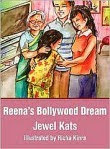
Learn to make your settings believable. Create a world or place that kids would like to be in; or at the very least see themselves in. Remember, to use your five senses when describing things. Don’t use generic descriptions or euphemisms that are overdone. Make it a point to think outside the box.
I personally love to get to know my characters. I go as far as charting their physical attributes, habits, hobbies, etc. I’ve even heard of some writers “interviewing” their characters to get to know them on a more intimate level. It’s important that your characters are three dimensional.
It’s also really important to create dialogue that’s real. If you’re writing a present-day story listen to and observe modern-day children. How do they speak? Listen with an open mind, and heart. Use current word choices. If you’re delving into the past, and writing a manuscript from another era do your research. And, do it accurately!
Speaking of research, take a look at what’s currently being published. Look up the publishers you’re targeting and see what they’re putting out in the market. Log onto their websites to gain access to up-to-date writer’s guidelines.
I always encourage aspiring writers to join critique groups, children’s writing workshops or organizations. Feedback from peers always helps, and offers another perspective. Guidance from experts is priceless. Besides, it’s always great to network with like-minded people.
I’ve learned to accept that rejection is a part of this business. Go back to the drawing board if refusals come your way. Try to figure out what went wrong with the manuscript, and perhaps even—dare I say?—finish writing another masterpiece. Maybe this time around, someone will spot your gem.
Lastly, never give up on yourself. Even if you do get published—such as in my case—speed bumps still can come your way. Sometimes the nasty ol’ writer’s block plants its big butt in your corner. What are you supposed to do? Get up, brush yourself off, and get back in the ring. Even if that means you have more bruises going in this time around!
Find out more about me and my book at the
 .
.














Great writing tips, Jewel!
I look forward to interviewing you next week on Book Bites for Kids!
Great advice. Thanks for sharing. I can imagine that writing for children comes with a lot of challenges!
This is great advice. Thanks for passing it along!
Excellent article. Not talking down to your audience is so important when dealing with young people.
Best of luck with your book.
Cheryl
Thanks for the tips. I especially like the one about not talking down to the reading audience. Good thing to remember.
Morgan Mandel
http://[email protected]
Great writing tips! Thanks for sharing them. Best wishes with your book.